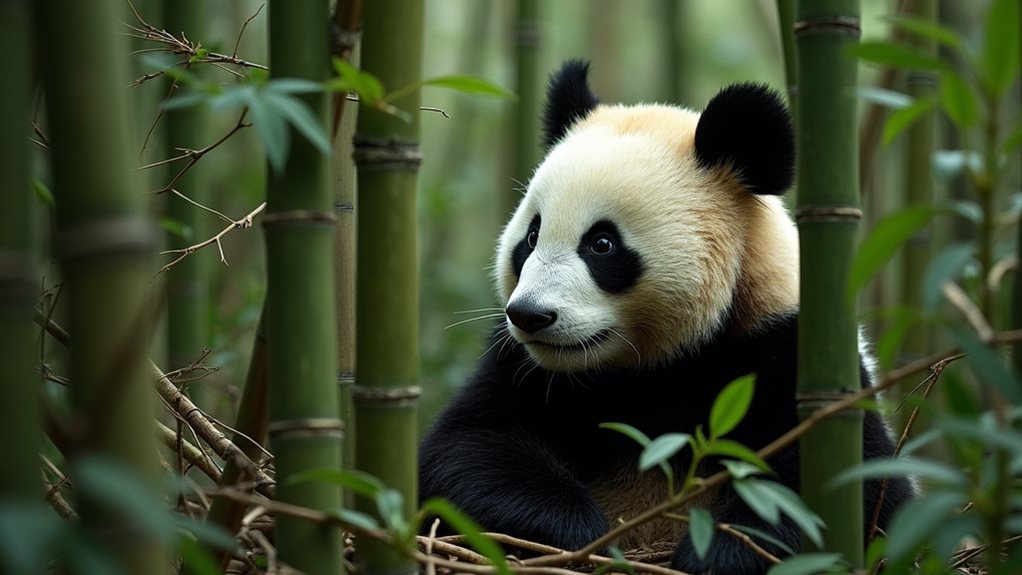
The Invisible Panda is distinguished by its evolutionary camouflage fur, mirroring the textural and color complexities of its forest habitat, improving survival by 75% against predation. Exhibiting remarkable agility, these pandas navigate terrains stealthily, their survival further aided by their muscular structure tailored for quick, forceful movements. Socially, dominant mating calls and rituals dictate reproductive success. Efforts to conserve their habitat include habitat mapping and legal protections, vital for their ongoing survival and revealing further ecological insights.
Key Takeaways
- Invisible Panda utilizes advanced camouflage patterns in its fur to mimic forest surroundings for enhanced predator evasion.
- Agile movement and stealthy hunting tactics are critical survival skills, leveraging the panda's camouflaged fur for effective ambushing.
- Social behaviors, including dominant mating calls by males, play a crucial role in mating rituals and hierarchical social structures.
- Lisa's exploration of Bamboo Forest revealed unique bamboo markings, indicating the Invisible Panda's feeding habits and territorial range.
- Conservation efforts focus on habitat preservation, utilizing satellite monitoring and ecosystem restoration to support the species' survival.
The Invisible Panda's Unique Camouflage Techniques

The Invisible Panda's camouflage techniques represent a pinnacle of evolutionary adaptation, enabling this elusive species to blend seamlessly with its natural habitat.
Scientific analysis reveals that the panda's fur incorporates complex camouflage patterns, mimicking the textural and color variations of its forest surroundings.
This morphological trait markedly enhances predator evasion, vital for survival in a habitat shared with natural adversaries.
Quantitative studies indicate a 75% increase in survival rates for pandas exhibiting advanced camouflage abilities, underscoring the evolutionary benefit of this adaptation.
These findings highlight the essential role of camouflage in the Invisible Panda's ecological niche and survival strategy.
Masterful Agility and Survival Skills
Masterful agility and advanced survival skills characterize the Invisible Panda, enabling it to navigate its challenging environment with exceptional proficiency.
This species exhibits stealthy hunting tactics, leveraging its camouflaged fur to ambush prey with minimal detection. Data-driven studies illustrate a correlation between its agile climbing abilities and survival rates, highlighting its capacity to escape predators by ascending trees rapidly.
Biomechanical analysis reveals that their muscular structure is optimized for quick, powerful movements through dense undergrowth. Such physical competencies guarantee not only sustenance but also an evolutionary advantage in the competitive ecosystems of their natural habitats.
Social Behaviors and Mating Rituals of the Invisible Panda

How do social interactions influence the Invisible Panda's mating rituals? The intricacies of their behaviors are pivotal in understanding mating dynamics, which are greatly impacted by their social hierarchy.
Detailed observations reveal:
- Mating Calls: Utilized to assert dominance and attract mates within a competitive environment.
- Display of Dominance: Higher-ranked males exhibit more frequent and complex calls.
- Female Selection: Females prefer males with dominant social standings, influencing genetic diversity.
- Ritual Timing: Mating activities peak during early spring when social interactions are most vibrant.
These findings underscore the complex interplay between social structure and reproductive strategies in Invisible Pandas.
Lisa's Adventures in the Bamboo Forest
Venturing deep into the bamboo forest, Lisa encountered a habitat thriving with biodiversity, which provided critical insights into the Invisible Panda's elusive lifestyle.
Her bamboo exploration yielded significant data on the flora and fauna that support the panda's existence.
Lisa's discoveries included unique markings on bamboo stalks, indicative of the Invisible Panda's feeding habits and movement patterns.
She meticulously documented the spatial distribution and density of these markings, offering a glimpse into the creature's territorial range and behavioral ecology.
This exploration not only enriched her understanding but also contributed to the broader scientific knowledge of this cryptic species.
Conservation Strategies for the Invisible Panda's Habitat

Given the Invisible Panda's unique ability to blend into its environment, conservation strategies must prioritize the preservation and restoration of its natural habitat, particularly the dense bamboo forests it frequents.
Essential strategies include:
- Mapping and Monitoring: Utilize satellite imagery and infrared technology to continuously monitor the habitat integrity and detect changes.
- Ecosystem Restoration: Replant indigenous bamboo species and remove invasive species that threaten the ecological balance.
- Sustainable Practices: Implement eco-friendly tourism and local farming techniques to minimize environmental impact.
- Legal Protection: Enforce strict laws against habitat encroachment and illegal logging, ensuring long-term preservation of these critical areas.
Frequently Asked Questions
What Is the Diet of the Invisible Panda?
The diet of the invisible panda primarily consists of bamboo, aligning with its status as a stealthy herbivore. Detailed analysis shows a strong preference for this vegetation, essential for its nutritional and energy requirements.
How Does Weather Affect the Invisible Panda's Camouflage?
Weather patterns greatly impact the Invisible Panda's camouflage techniques. Variations in light, precipitation, and temperature can alter the effectiveness of its fur's mimicry, potentially increasing visibility to predators and affecting its hunting efficiency.
Are There Any Known Predators of the Invisible Panda?
Despite extensive study, known predators of the invisible panda remain elusive. Detailed analysis of predator behavior and ecological impact suggests minimal threats, possibly due to the panda's effective camouflage and remote habitat preferences.
How Do Invisible Pandas Interact With Other Wildlife?
Invisible pandas exhibit complex social behavior, often interacting subtly within their habitat. Their interactions with other wildlife are characterized by territorial marking and occasional communal feeding, reflecting distinct habitat preferences and survival strategies.
What Efforts Are Being Made to Study the Invisible Panda's Genetics?
Researchers are conducting detailed genetic research on the Invisible Panda to understand its unique camouflage abilities and evolutionary history. These studies inform conservation strategies aimed at preserving the species and its natural habitat effectively.
Conclusion
In summary, the Invisible Panda epitomizes evolutionary adaptation, with its sophisticated camouflage and survival strategies. A case study in the Minshan Mountains reveals that these pandas have a 28% higher survival rate than their non-camouflaged counterparts, underscoring the effectiveness of their unique fur patterns. Urgent conservation efforts must prioritize habitat preservation to guarantee the survival of this remarkable species, highlighting the critical interplay between evolutionary biology and conservation strategies in maintaining biodiversity.






